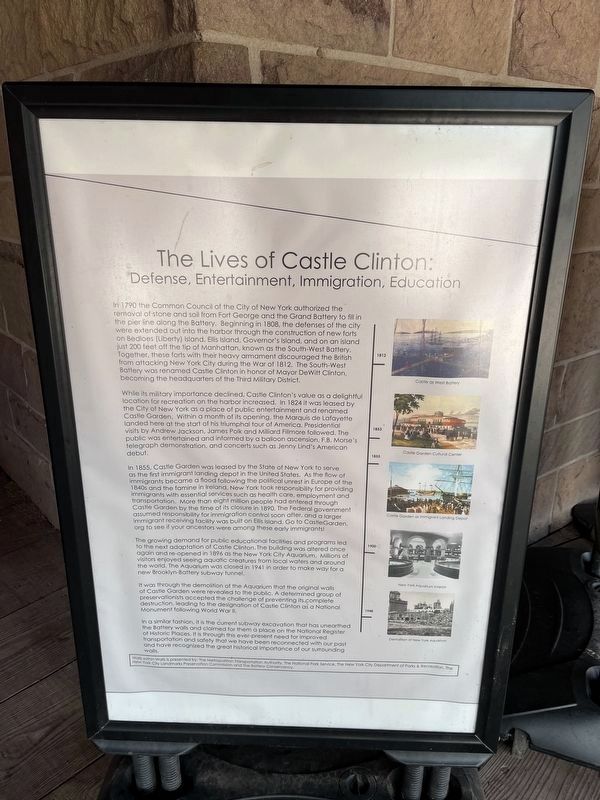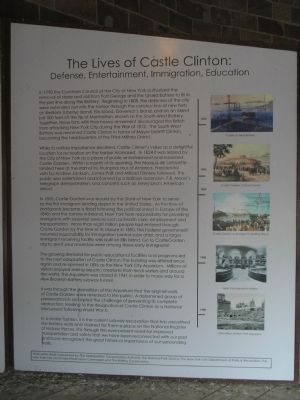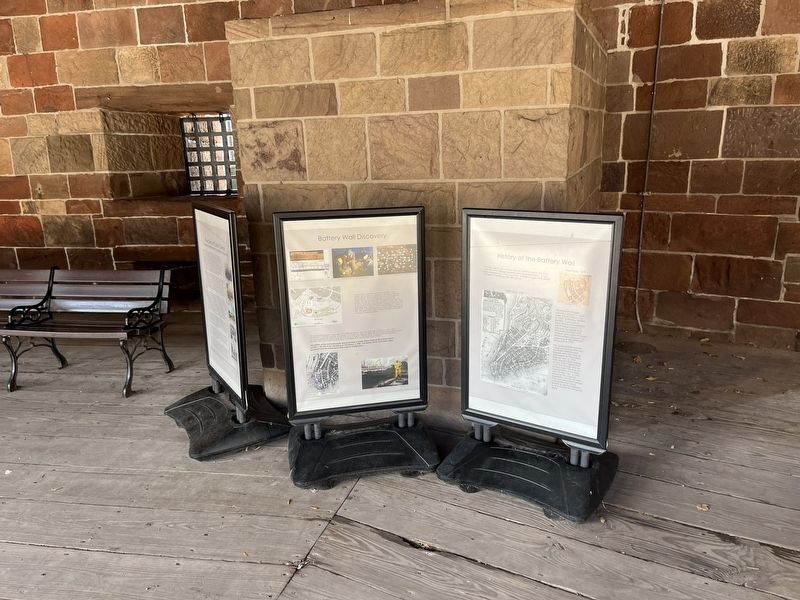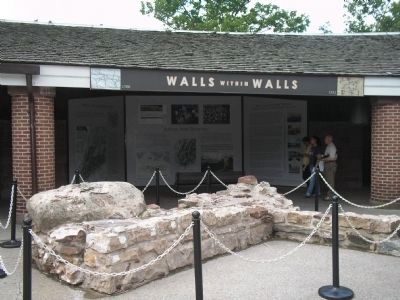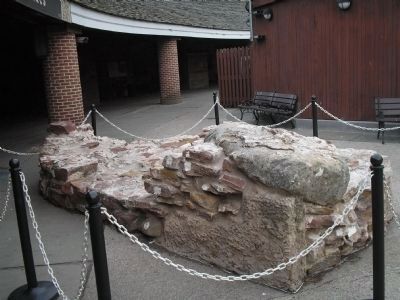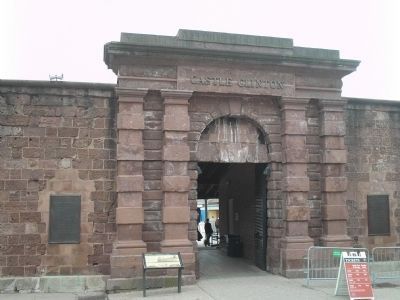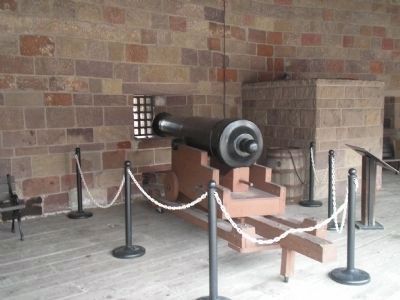Battery Park in Manhattan in New York County, New York — The American Northeast (Mid-Atlantic)
The Lives of Castle Clinton:
Defense, Entertainment, Immigration, Education
— [Castle Clinton National Monument] —
In 1790 the Common Council of the City of New York authorized the removal of stone and soil from Fort George and the Grand Battery to fill in the pier line along the Battery. Beginning in 1808, the defenses of the city were extended out into the harbor through the construction of new forts on Bedloes (Liberty) Island, Ellis Island, Governor’s Island, and on an island just 200 feet off the tip of Manhattan, known as the South-West Battery. Together, these forts with their heavy armament discouraged the British from attacking New York City during the War of 1812. The South-West Battery was renamed Castle Clinton in honor of Mayor DeWitt Clinton, becoming the headquarters of the Third Military District.
While its military importance declined, Castle Clinton’s value as a delightful location for recreation on the harbor increased. In 1824 it was leased by the City of New York as a place of public entertainment and renamed Castle Garden. Within a month of its opening, the Marquis de Lafayette landed here at the start of his triumphal tour of America. Presidential visits by Andrew Jackson, James Polk and Milliard Fillmore followed. The public was entertained and informed by a balloon ascension, F.B. Morse’s telegraph demonstration, and concerts such as Jenny Lind’s American debut.
In 1855, Castle Garden was leased by the State of New York to serve as the first immigrant landing depot in the United States. As the flow of immigrants became a flood following the political unrest in Europe of the 1840s and the famine in Ireland, New York took responsibility for providing immigrants with essential services such as health care, employment and transportation. More than eight million people had entered through Castle Garden by the time of its closure in 1890. The Federal government assumed responsibility for immigration control soon after, and a larger immigrant receiving facility was built on Ellis Island. Go to CastleGarden.org to see if your ancestors were among these early immigrants.
The growing demand for public education facilities and programs led to the next adaptation of Castle Clinton. The building was altered once again and re-opened in 1896 as the New York City Aquarium. Millions of visitors enjoyed seeing aquatic creatures from local waters and around the world. The Aquarium was closed in 1941 in order to make way for a new Brooklyn-Battery subway tunnel.
It was through the demolition of the Aquarium that the original walls of Castle Garden were revealed to the public. A determined group of preservationists accepted the challenges of preventing its complete destruction, leading to the designation of Castle Clinton as a National Monument following World War II.
In a similar
fashion, it is the same current subway excavation that has unearthed the Battery walls and claimed for them a place on the National Register of Historic Places. It is through this ever-present need for improved transportation and safety that we have been reconnected with our past and have recognized the great the great historical importance of our surrounding walls.
Erected by National Park Service, U.S. Department of the Interior.
Topics and series. This historical marker is listed in these topic lists: Education • Forts and Castles. In addition, it is included in the Former U.S. Presidents: #11 James K. Polk, the Former U.S. Presidents: #13 Millard Fillmore, and the Lafayette’s Farewell Tour series lists. A significant historical year for this entry is 1790.
Location. 40° 42.221′ N, 74° 1.018′ W. Marker is in Manhattan, New York, in New York County. It is in Battery Park. Marker can be reached from State Street, on the left when traveling north. Marker is located inside Castle Clinton National Monument in Battery Park. Touch for map. Marker is in this post office area: New York NY 10004, United States of America. Touch for directions.
Other nearby markers. At least 8 other markers are within walking distance of this marker. Battery Wall Discovery (here, next to this marker); History of the Battery Wall (here, next to this marker); Norwegian Maritime Memorial (a few steps
More about this marker. The right side of the marker contains a time line of Castle Clinton, containing pictures of it during various points in its history. These include the Castle as West Battery in 1812, Castle Garden as an Immigration Landing Depot in 1855, the New York Aquarium interior on 1900, and the 1948 demolition of the New York Aquarium.
Regarding The Lives of Castle Clinton:. The fort is listed in the "AIA (American Institute of Architects) Guide to New York City, Fifth Edition".
Related markers. Click here for a list of markers that are related to this marker. These markers are in the "Walls within Walls" exhibit
in Castle Clinton National Monument.
Also see . . .
1. Castle Clinton National Monument – History & Culture. National Park Service website. (Submitted on June 27, 2009, by Bill Coughlin of Woodland Park, New Jersey.)
2. Castle Clinton -- the Battery. "Daytonian in Manhattan" entry. (Submitted on April 13, 2020, by Larry Gertner of New York, New York.)
3. Castle Clinton National Monument - National Archives. National Register of Historic Places documentation (Submitted on April 7, 2024, by Anton Schwarzmueller of Wilson, New York.)
Credits. This page was last revised on April 7, 2024. It was originally submitted on June 27, 2009, by Bill Coughlin of Woodland Park, New Jersey. This page has been viewed 1,254 times since then and 40 times this year. Last updated on April 13, 2020, by Larry Gertner of New York, New York. Photos: 1. submitted on October 10, 2022, by Devry Becker Jones of Washington, District of Columbia. 2. submitted on June 27, 2009, by Bill Coughlin of Woodland Park, New Jersey. 3. submitted on October 10, 2022, by Devry Becker Jones of Washington, District of Columbia. 4, 5, 6, 7. submitted on June 27, 2009, by Bill Coughlin of Woodland Park, New Jersey. • Bill Pfingsten was the editor who published this page.
